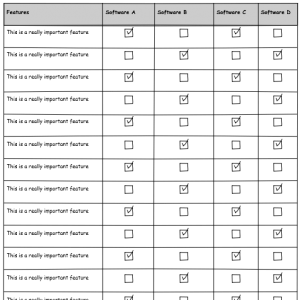- Do more
- Do it faster
- Do it better
- Do things you could do not do before
- Make your life easier
In just a few decades, software has transformed how most people work.
Software vendors have kept improving software and increasing productivity. Again and again.
Too Many Features
This led to endless feature wars between software vendors, each racing to produce the longest feature checklist. e.g.
- WordPerfect vs Word
- PowerPoint vs Harvard Graphics
- Oracle vs SQL Server
- Internet Explorer vs Netscape
- Excel vs Lotus 1-2-3 …

But when software has too many features, it gets more complicated. And esoteric features that only help a handful of people slow everyone else down as the software becomes bloated.
In the race to add more features, software product managers lost sight of the goal – productivity. With too many features, user interfaces become cluttered and the core, simple tasks take longer.
The Simplicity Principle
The benefits of simplicity have been “discovered” in many disciplines throughout the ages.
Among competing hypotheses, the one with the fewest assumptions should be selected.
Occam’s razor, 14th Century
Simplicity is the ultimate sophistication.
Leonardo da Vinci, 15th Century
Less is more.
1940s minimalist architecture
Make everything as simple as possible, but not simpler.
Albert Einstein
Keep it Simple, Stupid.
US Navy Engineering 1960
And re-discovered recently in software development approaches like Agile, Lean, and UX. Software developers are encouraged to be disciplined about focusing on the core job the software is used for.
The tide is turning and simplification has proved transformational.
Smartphone apps are small and simple. The constraint of a small screen forces app builders to strip away complexity and brings apps to billions of people.
Google search is another example. In early 2000’s internet companies developed vast portals and armies of people to curate the web for you. Stripping all that away has created a natural interface for all the information on the planet available in an instant.
Keeping software focused on its primary purpose improves productivity by reducing cognitive effort. Instead of forcing people to spend time thinking about how to use the software they can concentrate on the work at hand. Even micro breaks in concentration to find out how to do something cause them to switch context and slows them down.
Simplicity helps users and IT. People building business applications should be able to concentrate on the business requirements. How the business should use the system, what processes and rules are needed. Without them having to dive down and sort out lots of IT component parts.
How Can Simplicity Help You
Building systems for your company should be simple too. They should be simple to use and simple to build. For most IT teams, building a system is a complex, lengthy process, requiring different teams to:
- Procure and set up computer servers, security, and disaster recovery.
- Design and build database tables.
- Design and build forms to input data and reference data.
- Develop application business logic (calculations, process flows, access restrictions…)
- Design screens or reports to display data.
- Write code for audit logs and data interfaces to other systems.
This is a complex way to build applications
- It requires a lot of time and skilled people.
- When is has been built changes require a lot of work.
- The end result is a complex system. Complex for IT and complex for users.
LiveDataset Simplifies
LiveDataset simplifies building applications. LiveDataset provides a full environment including infrastructure, data storage, interfaces…. All you need to do is:
- Create an account at https://livedataset.com/start/
- Create datasets, and configure – like this…

- And just add data – like this…

Simple. LiveDataset is simple to use and makes it easy to build powerful business applications.

